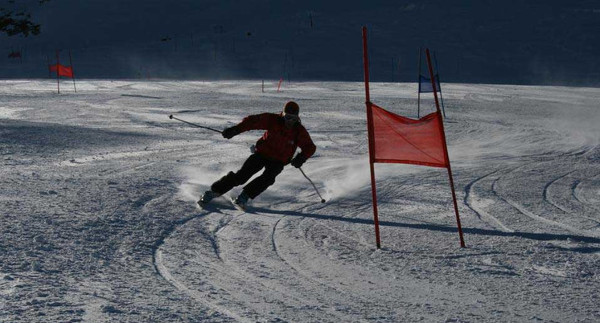Race skis split in two main categories: FIS and non-FIS. FIS is the acronym of International Ski Federation. Models that comply all the rules established by that organization are named FIS skis. The ones that don’t are classified as non-FIS. Easy, isn’t it?

The author enjoying an amateur race set trail a few years ago.
© SkiReviewer
FIS skis are not easily found at the shops. You will find them at shops that also happen to be the ski club providers. With non-FIS skis, though, it is a very different story. You will find them in every single shop because they are built with the general public in mind. They have some of the characteristics and touch you may find in their “older brothers”, the FIS skis, but without the huge physical and technical demands related to the competition environment the FIS models are meant to have.
Fischer Giant Slalom FIS model. 195cm length and 35m radius.
© Fischer Sports GmbH
So let’s take a look at the ones we are more interested in, the non-FIS, which are meant to be fun. The shape of these race skis allows us to accomplish turns easier, they are more permissive and also more available to a wider public. To ski at a competition level, you not only need to comply with the technical criteria. Having a good physical condition and a large skiing experience is absolutely necessary for being able to step in on a pair of FIS skis without becoming a dangerous threat to ourselves or others. However, we should not worry too much because on the top of the non-FIS range we will find enough powerful, fast, effective, precise and sporty skis for all of us.
In the high-end of these non-FIS race skis range, we find four general types of skis. They are the GS (Giant Slalom), SL (Special Slalom), Ski-Cross models and the On-Piste All Rounders. One step below of all these lines, we encounter the same master lines that characterize each type, but filled with models with a smoothed behavior. This downwards scaling can be structured into one or two steps below the top models.
Inside this top selection, there are some very good race skis that at first sight seem to break apart from the GS or SL skis but in reality they don’t. They are models which, in their longer sizes, have a GS-like touch and feel but are effectively more accessible. Also, they have a quite clear on-piste oriented nature. By contrast, in their shorter sizes, they show a quite similar behavior as the SL ones, but more polivalent in their use. They come with an overall lower round turn tendency.
They are both a wonderful choice for those in love with on-piste high quality skis, but don’t want to be compromised with the requirements of any of those two narrowed disciplines, and also want to avoid the smoothed behavior of the lowest models of the race array.
SkiReviewer’s Buying Skis Guide
1.- Sailing the Ski’s Gear Ocean – An introduction to variety
2.- To Buy Skis or To Rent Skis? – How worth is to own your skiing gear
3.- All Types of Skis Quick Guide
4.- Types of Skis – Explained one by one
6.- The Skier’s Height and Weight – And some other important considerations
8.- The Ski Size Chart explained – Tips and ideas for choosing the right ski at first sight
© SkiReviewer – All rights reserved

This is an excellent website. Can’t quite understand why I have not found it before.
If you are still active then I need some advice or help. I am 65 years old and weight 260 lbs. Now before you jump to conclusions I still bicycle quite a bit and go long distances (300 miles plus) several times per year and work out at least 2x per week. I have had prostate cancer and since then have been unable to loose the weight so that is my fate and I am glad to have it. Now my question: I ski in Colorado several times per year with expert skiers and we ski hard and fast. I raced back in my twenty’s and thirty’s but was too tall/big to get anywhere. I have having a devil of a time finding/demoing new skis. Currently I ski on 188cm Rossis Experience 98s but they will not hold a carving turn at high speed on hard snow. My gut tells me to go longer but finding 190cm+ demo skis is impossible. I am looking at a pair of 195cm Nordic Doberman GSL racing skis (2014-15) with plates. Also any other mfg. who produces a well known GS race ski in the 195cm range. Your thoughts?